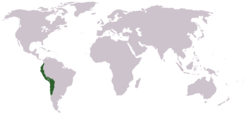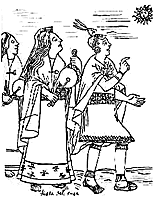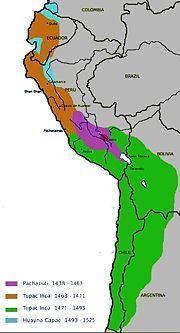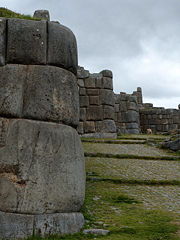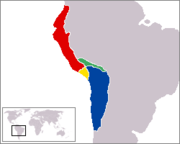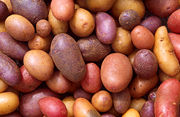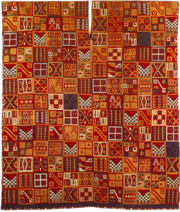Inca Empire
2008/9 Schools Wikipedia Selection. Related subjects: Ancient History, Classical History and Mythology; General history
|
|||||||||||||||||||||||||||||||||||||||||||||||||||||
The Inca Empire (or Inka Empire) was the largest empire in pre-Columbian America. The administrative, political and military centre of the empire was located in Cusco. The Inca Empire arose from the highlands of Peru sometime in early 13th century. From 1438 to 1533, the Incas used a variety of methods, from conquest to peaceful assimilation, to incorporate a large portion of western South America, centered on the Andean mountain ranges, including large parts of modern Ecuador, Peru, western and south central Bolivia, northwest Argentina, north and north-central Chile, and southern Colombia. The Incas identified their king as "child of the sun."
The Quechua name for the empire was Tawantinsuyu which can be translated as The Four Regions or The Four United Regions. Before the Quechua spelling reform it was written in Spanish as Tahuantinsuyo. Tawantin is a group of four things (tawa "four" with the suffix -ntin which names a group); suyu means "region" or "province". The empire was divided into four Suyus, whose corners met at the capital, Cusco (Qosqo), in modern-day Peru. The official language of the empire was Quechua, although dozens if not hundreds of local languages were spoken.
There were many local forms of worship, most of them concerning local sacred " Huacas", but the Inca leadership encouraged the worship of Inti — the sun god — and imposed its sovereignty above other cults such as that of Pachamama.
History
Origin myths
The Incas had various creation myths. In one, Ticci Viracocha sent forth his four sons and four daughters (known as the Ayar brothers) from Pacaritambo to establish a village. Along the way, Sinchi Roca was born to Manco and Ocllo, and Sinchi Roca led them to the valley of Cusco where they founded their new village. There Manco became their leader and became known as Manco Capac.
In another origin myth, the sun god Inti ordered Manco Capac and Mama Ocllo to emerge from the depths of Lake Titicaca. They were born in the lake and wandered north to establish the city of Cusco. They travelled by means of underground caves until they reached Cusco where they established Hurin Cusco, or the first dynasty of the Kingdom of Cusco.
These myths were apparently transmitted via oral tradition until early Spanish colonists recorded them; however some scholars believe that they may have been recorded on quipus (Andean knotted string records).
Kingdom of Cusco
The Inca people began as a tribe in the Cusco area around the 12th century. Under the leadership of Manco Capac, they formed the small city-state of Cusco ( Quechua Qusqu), shown in red on the map. In 1438 they began a far-reaching expansion under the command of Sapa Inca (paramount leader) Pachacuti, whose name literally meant "earth-shaker". During his reign, he and his son brought much of the Andes mountains (roughly modern Peru and Ecuador) under Inca control.
Reorganization and formation of the Empire
Pachacuti reorganized the kingdom of Cuzco into an empire, the Tahuantinsuyu, a federalist system which consisted of a central government with the Inca at its head and four provincial governments with strong leaders: Chinchasuyu (NW), Antisuyu (NE), Contisuyu (SW), and Collasuyu (SE). Pachacuti is also thought to have built Machu Picchu, either as a family home or as a summer retreat.
Pachacuti sent spies to regions he wanted in his empire; they brought reports on the political organization, military might and wealth. He would then send messages to the leaders of these lands extolling the benefits of joining his empire, offering them presents of luxury goods such as high quality textiles, and promising that they would be materially richer as subject rulers of the Inca. Most accepted the rule of the Inca as a fait accompli and acquiesced peacefully. The ruler's children would then be brought to Cuzco to be taught about Inca administration systems, then return to rule their native lands. This allowed the Inca to indoctrinate the former ruler's children into the Inca nobility, and, with luck, marry their daughters into families at various corners of the empire.
Expansion and consolidation of the Tawantinsuyu
It was traditional for the Inca's son to lead the army; Pachacuti's son Túpac Inca Yupanqui began conquests to the north in 1463, and continued them as Inca after Pachucuti's death in 1471. His most important conquest was the Kingdom of Chimor, the Inca's only serious rival for the coast of Peru. Túpac Inca's empire stretched north into modern day Ecuador and Colombia.
Túpac Inca's son Huayna Cápac added a small portion of land to the north in modern day Ecuador and in parts of Peru. At its height, Tahuantinsuyu included Peru and Bolivia, most of what is now Ecuador, a large portion of what is today Chile north of Maule River, where they met massive resistance by the Mapuche tribes. The empire also extended into corners of Argentina and Colombia. However, most of the southern portion of the Inca empire, the portion denominated as Collasuyu, was desert wasteland.
Tahuantinsuyu was a patchwork of languages, cultures and peoples. The components of the empire were not all uniformly loyal, nor were the local cultures all fully integrated. The Inca empire as a whole had an economy based on exchange and taxation of luxury goods and labour (it is said that Inca tax collectors would take the head lice of the lame and old as a symbolic tribute).
Inca civil war and Spanish conquest
Spanish conquistadors led by Francisco Pizarro and his brothers explored south from Panama, reaching Inca territory by 1526. It was clear that they had reached a wealthy land with prospects of great treasure, and after one more expedition (1529), Pizarro traveled to Spain and received royal approval to conquer the region and be its viceroy.
At the time they returned to Peru, in 1532, a war of the two brothers between Huayna Capac's sons Huascar and Atahualpa and unrest among newly-conquered territories — and perhaps more importantly, smallpox, which had spread from Central America — had considerably weakened the empire. It was an unfortunate fact for the Inca that the Spaniards arrived at the height of a civil war, fueled almost certainly by the devastating diseases that preceded the European colonization.
Pizarro did not have a formidable force; with just 168 men, 1 cannon and only 27 horses, he often needed to talk his way out of potential confrontations that could have easily wiped out his party. The Spanish horseman, fully armored, had great technological superiority over the Inca forces. The traditional mode of battle in the Andes was a kind of siege warfare where large numbers of usually reluctant draftees were sent to overwhelm opponents. The Spaniards had developed one of the finest military machines in the premodern world, tactics learned in their centuries' long fight against Moorish kingdoms in Iberia. Along with this tactical and material superiority, the Spaniards also had acquired tens of thousands of native allies who sought to end the Inca control of their territories. This, combined with an audacious military attack by the Spaniards in Cajamarca, allowed them to capture the emperor and send the Inca elite into a huge and paralyzing political struggle. Atahualpa ordered the death of his opponent, Huascar, and the Spaniards skillfully manipulated the various factions within the Inca state. They also were able to continually increase their native allies and ultimately launched a successful attack on the capital city of Cuzco.
Their first engagement was the Battle of Puná, near present-day Guayaquil, Ecuador on the Pacific Coast; Pizarro then founded the city of Piura in July 1532. Hernando de Soto was sent inland to explore the interior, and returned with an invitation to meet the Inca, Atahualpa, who had defeated his brother in the civil war and was resting at Cajamarca with his army of 80,000 troops.
Pizarro and some of his men, most notably a friar by the name of Vincente de Valverde met with the Inca, who had brought only a small retinue. Through an interpreter Friar Vincente demanded that he and his empire accept the yoke of King Charles I of Spain and convert to Christianity. Due to the language barrier and perhaps poor interpretation, Atahualpa became somewhat puzzled by the friar's description of Christian faith and was said to have not fully understood the envoy's intentions. After Atahualpa attempted further enquiry into the doctrines of the Christian faith under which Pizarro's envoy served, the Spanish became frustrated and impatient, attacking the Inca's retinue (see Battle of Cajamarca) and capturing Atahualpa as hostage.
Atahualpa offered the Spaniards enough gold to fill the room he was imprisoned in, and twice that amount of silver. The Inca fulfilled this ransom, but Pizarro deceived them, refusing to release the Inca afterwards. During Atahualpa's imprisonment Huascar was assassinated elsewhere. The Spaniards maintained that this was at Atahualpa's orders; this was used as one of the charges against Atahualpa when the Spaniards finally decided to put him to death, in August 1533.
The last Incas
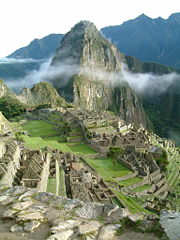
The Spanish installed Atahualpa's brother Manco Inca Yupanqui in power; for some time Manco cooperated with the Spanish, while the Spanish fought to put down resistance in the north. Meanwhile an associate of Pizarro's, Diego de Almagro, attempted to claim Cuzco for himself. Manco tried to use this intra-Spanish feud to his advantage, recapturing Cuzco (1536), but the Spanish retook the city afterwards. Manco Inca then retreated to the mountains of Vilcabamba, Peru, where he and his successors ruled for another 36 years, sometimes raiding the Spanish or inciting revolts against them. In 1572 the last Inca stronghold was conquered, and the last ruler, Túpac Amaru, Manco's son, was captured and executed. This ended resistance to the Spanish conquest under the political authority of the Inca state.
After the fall of Tahuantinsuyu, the new Spanish rulers brutally oppressed the people and suppressed their traditions. Many aspects of Inca culture were systematically destroyed, including their sophisticated farming system. The Spaniards used the Inca mita (mandatory public service) system to literally work the people to death. One member of each family was forced to work in the gold and silver mines, the foremost of which was the titanic silver mine at Potosí. When a family member died, which would usually happen within a year or two, the family would be required to send a replacement.
The effects of smallpox on the Inca empire were even more devastating. Beginning in Colombia, smallpox spread rapidly before the Spanish invaders first arrived in the empire. The spread was probably aided by the efficient Inca road system. Within months, the disease had killed the Sapa Inca Huayna Capac, his successor, and most of the other leaders. Two of his surviving sons warred for power and, after a bloody and costly war of the two brothers, Atahualpa become the new Sapa Inca. As Atahualpa was returning to the capital Cuzco, Francisco Pizarro arrived and through a series of deceits captured the young leader and his best general. Within a few years smallpox claimed between 60% and 94% of the Inca population, with other waves of European disease weakening them further. Smallpox was only the first epidemic.
Typhus (probably) in 1546, influenza and smallpox together in 1558, smallpox again in 1589, diphtheria in 1614, measles in 1618 - all ravaged the remains of Inca culture.
Society
Organization of the Empire
The most powerful figure in the empire was the Sapa Inca ('the unique Inca'). Only descendants of the original Inca tribe ever ascended to the level of Inca. Most young members of the Inca's family attended Yachay Wasis (houses of knowledge) to obtain their education.
The Tawantinsuyu was a federalist system which consisted of a central government with the Inca at its head and four provinces: Chinchay Suyu (NW), Anti Suyu (NE), Kunti Suyu (SW), and Qulla Suyu (SE). The four corners of these provinces met at the centre, Cusco. Each province had a governor who oversaw local officials, who in turn supervised agriculturally-productive river valleys, cities and mines. There were separate chains of command for both the military and religious institutions, which created a system of partial checks and balances on power. The local officials were responsible for settling disputes and keeping track of each family's contribution to the mita (mandatory public service).
Language
For more information look at Quechua
Since the Inca Empire lacked a written language, the empire's main form of communication and recording came from quipus and Quechua, the language the Incas imposed upon the peoples within the empire. The plethora of civilizations in the Andean region provided for a general disunity that the Incas needed to subdue in order to maintain control, peace, and order within all of the empire. Hence, by establishing a uniform language, the Incas would be able to better achieve such a goal. Nonetheless, it should be noted that Quechua had been spoken in the Andean region, like central Peru, for several years prior to the expansion of the Inca civilization. Moreover, the type of Quechua the Incas imposed was an adaptation from the Kingdom of Cusco (an early form of "Southern Quechua") of what some historians define as "Proto-Quechua" (The original Quechua dialect).
As in many societies of the world, the language imposed by the Incas further diverted from its original phonetic tone as some societies formed their own regional varieties, or slang. Of course, the diversity of Quechua at that point and even today does not come as a direct result from the Incas, whom are just a part of the reason for Quechua's diversity. The civilizations within the empire that had previously spoken Quechua kept their own variety distinct to the Quechua the Incas spread. Although these many kinds of Quechua were in some form similar, they were not the exact same thing. Not only that, but even though most of the societies within the empire implemented Quechua into their lives, the Incas allowed several societies kept their old languages such as Aymara, which still remains a spoken language in various parts of South America. The linguistic body of the Tawantinsuyu was thus still largely varied, but it still remains quite an achievement for the Incas that went even beyond their times as the Spanish continued to use the spread of Quechua as a method to impose their culture upon the peoples of South America (even though that further increased the diversity of the language).
On the other hand, the actual "Inca," or ruling elite, their kind of Quechua tended to remain somewhat closer to the "early Southern Quechua" of the Kingdom of Cusco mainly due to the complex educational facilities the Tawantinsuyu offered them. This standardized governmental Quechua is what served as the backbone for the Tawantinsuyu, but it also differentiated the social status of the community. Moreover, some historians even discuss the possibility that the "secret language" of the ruling elite might have simply been another form of Quechua.
Life, education and beliefs
The Inca diet consisted primarily of potatoes and grains, supplemented by fish, vegetables, nuts, and maize (corn). Camelid (llama and alpaca) meat and cuyes (guinea pigs) were also eaten in large quantities.. In addition, they hunted various wild animals for meat, skins and feathers. Maize was malted and used to make chicha, a fermented alcoholic beverage. The Inca road system was key to farming success as it allowed distribution of foodstuffs over long distances. The Inca also constructed vast storehouses, which allowed them to live through El Niño years while neighboring civilizations suffered.
The Inca believed in reincarnation. Those who obeyed the Incan moral code — ama suwa, ama llulla, ama quella (do not steal, do not lie, do not be lazy) — "went to live in the Sun's warmth while others spent their eternal days in the cold earth". The Inca also practiced cranial deformation. They achieved this by wrapping tight cloth straps around the heads of newborns in order to alter the shape of their still-soft skulls into a more conical form. Studies are needed to determine whether these deformations caused actual brain damage.
Aqllawasi
The Aqllawasi (Acllahuasi) which means "house of the sun virgins" was developed under the Incans in Peru at about 1438–1532 CE. Its central purpose was in the manufacturing of garments for the Inca royalty and the worship of the sun god, Inti.
Arts and technology
Monumental architecture
Architecture was by far the most important of the Inca arts, with pottery and textiles reflecting motifs that were at their height in architecture. The main example is the capital city of Cuzco itself. The breathtaking site of Machu Picchu was constructed by Inca engineers. The stone temples constructed by the Inca used a mortarless construction that fit together so well that you couldn't fit a knife through the stonework. This was a process first used on a large scale by the Pucara (ca. 300 BC–AD 300) peoples to the south in Lake Titicaca, and later in the great city of Tiwanaku (ca. AD 400–1100) in present day Bolivia. The Inca imported the stoneworkers of the Tiwanaku region to Cuzco when they conquered the lands south of Lake Titicaca. The rocks used in construction were sculpted to fit together exactly by repeatedly lowering a rock onto another and carving away any sections on the lower rock where the dust was compressed. The tight fit and the concavity on the lower rocks made them extraordinarily stable.
Ceramics, precious metal work, and textiles
Almost all of the gold and silver work of the empire was melted down by the conquistadores. Ceramics were painted in numerous motifs including birds, waves, felines, and geometric patterns. The most distinctive Inca ceramic objects are the Cusco bottles or ¨aryballos¨. Many of these pieces are on display in Lima in the Larco Archaeological Museum and the National Museum of Archaeology, Anthropology and History.
Mathematics and astronomy
A very important Inca technology was the Quipu, which were assemblages of knotted strings used to record information, the exact nature of which is no longer known. Originally it was thought that Quipu were used only as mnemonic devices or to record numerical data. Recent discoveries, however, have led to the theory that these devices were instead a form of writing in their own right.
The Inca made many discoveries in medicine. They performed successful skull surgery, which involved cutting holes in the skull to release pressure from head wounds. Coca leaves were used to lessen hunger and pain, as they still are in the Andes. The Chasqui (messengers) chewed coca leaves for extra energy to carry on their tasks as runners delivering messages throughout the empire.
Weapons, armor, and warfare
The Incas used weapons and had wars with other civilizations in the area. The Inca army was the most powerful in the area at that time, because they could turn an ordinary villager or farmer into a soldier, ready for battle. This is because every male Inca had to take part in war at least once so as to be prepared for warfare again when needed. By the time the empire had reached its large size, every section of the empire contributed in setting up an army for war.
The Incas had no iron or steel, and their weapons were no better than those of their enemies. They went into battle with the beating of drums and the blowing of trumpets. The armor used by the Incas included:
- Helmets made of wood, copper, bronze, cane, or animal skin; some were adorned with feathers
- Round or square shields made from wood or hide
- Cloth tunics padded with cotton and small wooden planks to protect spine
The Inca weaponry included:
- Bronze or bone-tipped spears
- Two-handed wooden swords with serrated edges (notched with teeth, like a saw)
- Clubs with stone and spiked metal heads
- Woolen slings and stones
- Stone or copper headed battle-axes
- Stones fastened to lengths of cord (bola)
Roads allowed very quick movement for the Inca army, and shelters called quolla were built one day's distance in travelling from each other, so that an army on campaign could always be fed and rested. (The name for the Sapa Inca's storehouses was tambo. This can be seen in names of ruins such as Ollantay Tambo, or My Lord's Storehouse. These were set up so the Inca and his entourage would always have supplies (and possibly shelter) ready as he traveled.)
Inca flag
There are 16th and 17th century chronicles and references that support the idea of a banner, or flag, attributable to the Inca.
Francisco López de Jerezwrote in 1534:
"all of them came distributed into squads, with their flags and captains commanding them, as well-ordered as Turks"
("todos venían repartidos en sus escuadras con sus banderas y capitanes que los mandan, con tanto concierto como turcos").
The chronicler, Bernabé Cobo, wrote:
"The royal standard or banner was a small square flag, ten or twelve spans around, made of cotton or wool linen, placed on the end of a long staff, stretched and stiff such that it did not wave in the air, and on it each king painted his arms and emblems, for each one chose different ones, though the sign of the Incas was the rainbow."
(...el guión o estandarte real era una banderilla cuadrada y pequeña, de diez o doce palmos de ruedo, hecha de lienzo de algodón o de lana, iba puesta en el remate de una asta larga, tendida y tiesa, sin que ondease al aire, y en ella pintaba cada rey sus armas y divisas, porque cada uno las escogía diferentes, aunque las generales de los Incas eran el arco celeste.)
-Bernabé Cobo, Historia del Nuevo Mundo (1653)
Guaman Poma's 1615 book, El primer nueva corónica y buen gobierno, shows numerous line drawings of Inca flags.
In modern times the rainbow flag has been associated with the Tawantinsuyu and is displayed as a symbol of Inca heritage in Peru and Bolivia. The city of Cusco flies the Rainbow Flag. Peruvian President Alejandro Toledo (2001–2006) flew the Rainbow Flag in Lima's presidential palace. The Rainbow Flag was taken down by President Alan Garcia in July 2006.
Legacy
The major languages of the empire, Quechua and Aymara, were employed by the Roman Catholic Church to evangelize in the Andean region. In some cases, these languages were taught to peoples who had originally spoken other indigenous languages. Today, Quechua and Aymara remain the most widespread Amerindian languages.those who spoke these two languages were regarded higher than the others and referred to as middle-class
